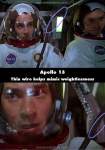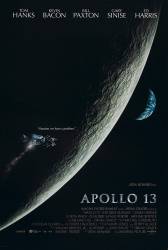Factual error: Hanks as Lovell drives a red corvette. The real Lovell has said in interviews he drove a blue corvette.
Factual error: As Lovell explains the Apollo 1 fire to his son (in 1967), a large RC model aircraft can be seen over the child's shoulder. The N-Number (tail number) for FAA registration is N1976M. The particular aircraft represented on screen is a Cessna 182P - which according to FAA records - wasn't built until 1976. (00:14:50)
Continuity mistake: When Lovell and Haise discuss their families and Haise's illness, Lovell grabs a picture of Mary from the air and comments on, while Haise is seen putting a green letter back into its envelope. It cuts to show a close-up of Haise's hands pulling the letter and the photo from the envelope as if he just opened it (which would have happened moments earlier).
Continuity mistake: When Capcon 1 and John Young are watching Haise start to play the background music they are standing near their fairly clean desks in Mission Control. About 20 seconds later, after the Haise children laugh and Lovell says there seems to have been a last-minute change in the programme, the camera shows Capcon 1 and Young now seated eating dinner. Considering the amount of junk food now laid over their area and Capcon 1 half-way through eating his burger they appear to have been eating for at least several minutes, not 20 seconds. (00:46:00)
Character mistake: When Marilyn asks Henry "Do they know they're not on the air?" her finger is pointing just below her face. In the next frame with the camera now facing the pair, her hand is down at her lap. (00:47:00)
Continuity mistake: When Blanche is waiting for her son's broadcast to appear on TV she is seated beside two women. When she is told "this is all the channels we get" the middle woman moves her left hand to her face. In the next frame with the camera angle in front of the viewers the middle woman's left hand is at her lap. (00:46:00)
Continuity mistake: During the re-entry sequence, there is a shot of all the condensation from the control panel pouring over the astronauts. The next set close up shots of the men's faces show them to be completely dry. (02:05:55)
Factual error: At the end of the movie, when the astronauts debark from the helicopter and are surrounded by the crew of the U.S.S. Iwo Jima, there are a number of junior enlisted men wearing combination caps. (The type worn by Chief Petty Officers and commissioned officers.) That they are junior enlisted men is obvious by the rank insignia on their left sleeves and by the silver USN and Eagle emblem on their caps. (Chief's caps have a large gold and silver anchor insignia, and officer's caps have a large gold officer's crest.) The U.S. Navy did, for a few years, replace the junior enlisted men's traditional white hat with the combination cap, but the change was not announced until 1972, two years after the Apollo 13 mission, and the Navy reverted to white hats in 1983, twelve years before the movie was made.
Continuity mistake: The direction of the spacecraft keeps changing. After the extraction of the LM (Lunar Module), the craft is travelling with the CSM (Command/Service Module) engine bell facing forward. After the explosion, it is shown with the LM facing forward. Going around the moon, and back to earth, the CSM is again facing forward.
Suggested correction: The orientation of the spacecraft was not constant. There is no reason why it should be (and, indeed, good reason why it won't). Apollo 13 did indeed have the LM leading at some points and the CSM leading at others.
Audio problem: During the scene with the astronauts building the makeshift CO2 scrubber, Jack and Fred are getting the tape ready and tearing it lengthwise. Capgo says, "Alright," indicating he was going to move to the next step. Fred responds, "Hold on, Houston." Bill Paxton's mouth does not move, and he is visible.
Factual error: On July 20, 1969, the moon phase was waxing crescent. In the movie, on the eve of the moon landing, the moon is shown in waxing gibbous phase when Lovell (Hanks) covers the moon with his thumb. (00:06:02)

Visible crew/equipment: During Marilyn Lovell's nightmare, the crew experiences cabin decompression. Right when the master alarm goes off, you see a piece of monofilament attached to Jim Lovell's suit hose, used to try and simulate zero G to make the hose appear to be floating. (00:13:20)
Continuity mistake: At the beginning of the "Failure Is Not an Option" scene, Gene writes "45 hrs" on the chalkboard. In the close-up as he writes it, the front of the 4 is curved into the spine, and the 5 is written with a flat top and flat back leading into the curve underneath. Then, Gene puts a period after "hrs." When the shot cuts wide, the 5 looks more like an S and the top of the five is curled back under. The spine of the 4 has become much longer as well. When Gene walks back to the board at the end of the scene, the front of the 4 is more angular than curved, and the 5 still looks like an S but the curl under the top line is gone. And, once the shot changes away from Gene writing it, the period after "hrs" disappears for the rest of the scene. (01:15:50 - 01:17:45)





